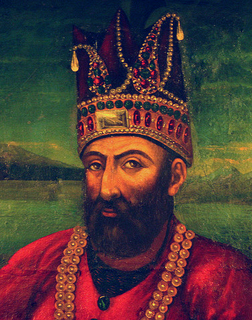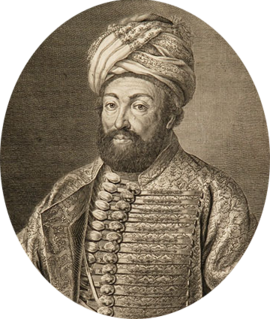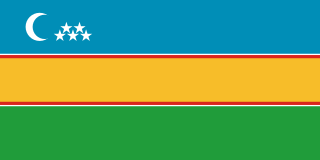
Agha Mohammad Khan Qajar, also known by his regnal name of Agha Mohammad Shah, was the founder of the Qajar dynasty of Iran, ruling from 1789 to 1797 as king (shah). Originally chieftain of the Qoyunlu branch of the Qajar tribe, Agha Mohammad Khan was enthroned as the king of Iran in 1789, but was not officially crowned until March 1796, having deposed Lotf Ali Khan of the Zand dynasty in 1794. Agha Mohammad Khan Qajar was famously the eunuch Monarch, being castrated as a young adult upon his capture by Adel Shah Afshar, and hence was childless. On June 17, 1797, he was assassinated, and was succeeded by his nephew, Fath-Ali Shah Qajar.

Fath-Ali Shah Qajar was the second Shah of Iran. He reigned from 17 June 1797 until his death. His reign saw the irrevocable ceding of Iran's northern territories in the Caucasus, comprising what is nowadays Georgia, Dagestan, Azerbaijan, and Armenia, to the Russian Empire following the Russo-Persian Wars of 1804–13 and 1826–28 and the resulting treaties of Gulistan and Turkmenchay. Historian Joseph M. Upton says that he "is famous among Persians for three things: his exceptionally long beard, his wasp-like waist, and his progeny."
Nadir Mirza Afshar was great-grandson of Nader Shah the founder of the Afsharid dynasty of Persia. He was the fourth son of Shahrukh Afshar emperor of Khorasan.

Donboli are a Turkic-speaking sub-ethnic group of Kurds originality in the Khoy khanate and Tabriz khanate regions of West Azarbaijan Province of Iran.
The Karai or Qarai Turks, calling themselves Persian: قراي تركلر or Persian: ترک های سیاه, are a Turkic-speaking minority mostly found in Khorasan and Iran especially Torbat-e Heydarieh.

Nader Shah Afshar was one of the most powerful Iranian rulers in the history of the nation, ruling as Shah of Iran (Persia) from 1736 to 1747 when he was assassinated during a rebellion. Because of his military genius as evidenced in his numerous campaigns throughout Middle East, Caucasus, Central and South Asia, such as the battles of Herat, Mihmandust, Murche-Khort, Kirkuk, Yeghevard, Khyber Pass, Karnal and Kars, some historians have described him as the Napoleon of Persia, Sword of Persia, or the Second Alexander. Nader Shah was an Iranian who belonged to the Turkmen Afshar tribe of Khorasan in northeastern Iran, which had supplied military power to the Safavid dynasty since the time of Shah Ismail I.

Mirza Abolhassan Khan Shirazi Ilchi Kabir was an Iranian statesman who served as the Minister of Foreign Affairs from 1824 to 1834, and then again from 1838 until his death in 1846. He also served as the ambassador to Imperial Russia and Great Britain, and was the main Iranian delegate at the signing of the notorious Treaty of Gulistan (1813) with neighbouring Russia.
Azād Khān Afghān, or Azād Shāh Afghān, was a Pashtun military commander and a major contender for supremacy in western Iran after the death of Nader Shah Afshar in 1747. Azad rose to power between 1752 and 1757, and controlled part of the Azerbaijan region up to Urmia city, northwestern and northern Persia, and parts of southwestern Turkmenistan and eastern Kurdistan. Azad was a contemporary of Ahmad Shah Durrani, the founder of the Durrani Empire.

Ebrahim Khan Zahir od-Dowleh was an Iranian statesman from the Qajar dynasty. He is mostly known for his 22-year-old governorship of the Kerman Province (1803-1824).
Ebrahim Kalantar Shirazi, also known as Hajji Ebrahim and E'temad al-Dawla, was an influential Iranian politician in the Zand and Qajar era.
The Tabriz khanate was one of the Caucasian khanates, located in historic Azerbaijan which became for nearly fifty years semi-independent from the Iranian mothercountry.
Khoy Khanate was an Iranian khanate in the province of Azerbaijan. The city of Khoy was inhabited and ruled by the Donboli clan, a Kurdish tribe originally from Anatolia, since the 14th century B.C. In 1530 Hajji Beg Donboli, son of Sheikh Ahmad Beg, received the rule over Khoy and Sokmanabad on behalf of the Safavid Shah Tahmasp II and could establish his family's rule over the whole area and finally also over the city of Tabriz, where another branch ruled the Tabriz Khanate.
After Nader Shah was assassinated in 1747, his nephew Ali Qoli seized the throne and proclaimed himself Adil Shah. He ordered the execution of all Nader's sons and grandsons, with the exception of the 13-year-old Shahrokh, the son of Reza Qoli. Meanwhile, Nader's former treasurer, Ahmad Shah Abdali, had declared his independence by founding the Durrani Empire. In the process, the eastern territories were lost and in the following decades became part of Afghanistan, the successor-state to the Durrani Empire. The Ottomans regained lost territories in Eastern Anatolia and Mesopotamia. The northern territories, Iran's most integral regions, had a different fate. Erekle II and Teimuraz II, who, in 1744, had been made the kings of Kakheti and Kartli respectively by Nader himself for their loyal service, capitalized on the eruption of instability, and declared de facto independence. Erekle II assumed control over Kartli after Teimuraz II's death, thus unifying the two as the Kingdom of Kartli-Kakheti, becoming the first Georgian ruler in three centuries to preside over a politically unified eastern Georgia. Due to the frantic turn of events in mainland Iran he would be able to remain de facto autonomous through the Zand period. Under the successive Qajar dynasty, Iran managed to restore Iranian suzerainty over the Georgian regions, until they would be irrevocably lost in the course of the 19th century, to neighbouring Imperial Russia. Meanwhile, Azad Khan Afghan managed to take control over the land between the Aras river, and the Urmia Lake by 1750. Azad Khan would later go on to capture Isfahan and occupy Shiraz, before losing all his territories by 1758 to Karim Khan. Meanwhile, the Absheron Peninsula and surrounding territories, were under the control of the Khanate of Baku, while the Avar Khanate took control over modern day Dagestan. Alongside eastern Georgia, these territories would all be re-incorporated into Iran but eventually permanently and irrevocably lost as well in the course of the 19th century, through the two Russo-Persian Wars of the century, to neighbouring Imperial Russia. Lastly, Oman and the Uzbek khanates of Bukhara and Khiva regained independence. The Afsharid dynasty would continue to live on in parts of Khorasan with Mashhad as the capital. When the Zand empire expanded rapidly, Karim khan allowed the Afsharids to continue rule in Khorasan, showing his respect for Nader Shah. It was eventually dissolved upon the Qajars ascension to the throne.
Hasan-Ali Beg Bestami was an important Safavid official, who subsequently became one of the closest associates of Nader Shah, serving as his chief assayer.
Ali Mardan Khan Bakhtiari was the Bakhtiari supreme chieftain (ilkhani) of the Chahar Lang branch, and major contender for supremacy in western Iran after the death of Nader Shah in 1747.
Hossein Qoli Khan Qajar was the Qajar chieftain of the Qoyunlu branch from 1759 till his death in 1777.



















